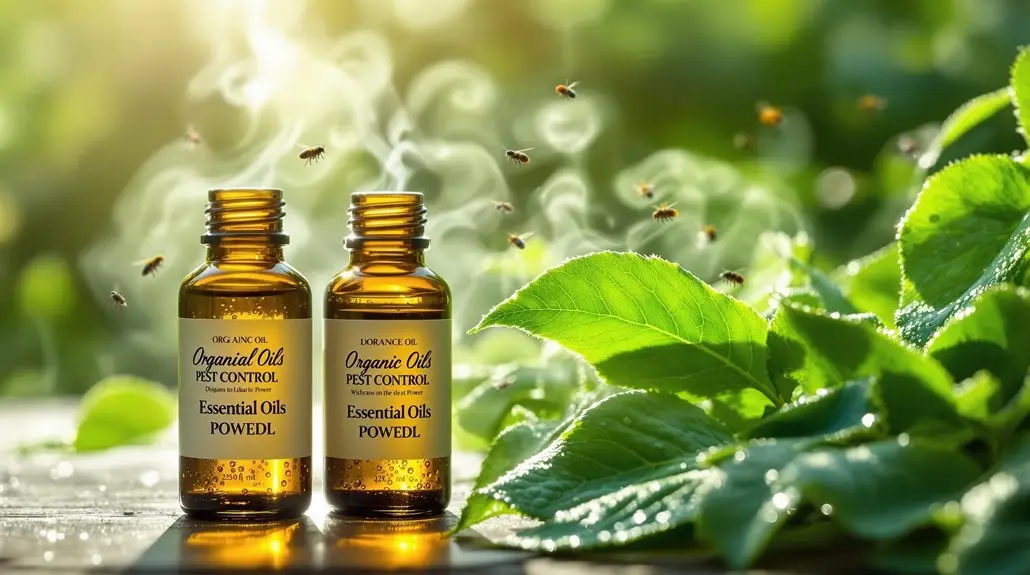Botanical essential oils are a powerful option for controlling insect pests, offering both effectiveness and sustainability. They interact with insect receptors, disrupting behaviors and causing mortality. Oils like citronella and peppermint can repel and kill pests like mosquitoes and ticks, achieving high efficacy rates. They’re also non-toxic to humans and biodegradable, making them a more secure choice than synthetic pesticides. These oils fit well into Integrated Pest Management strategies, promoting a diverse approach to pest control. If you’re curious about specific oils and application methods, there’s plenty more to uncover in this fascinating area of pest management.
Key Insights
- Essential oils exhibit insecticidal activity against a wide range of pests, effectively combating mosquitoes, ticks, and flies through natural composition.
- They disrupt insect feeding behaviors by interacting with octopamine receptors, leading to significant mortality and reduced survival.
- Essential oils are biodegradable and non-toxic to mammals, minimizing environmental impact compared to synthetic pesticides.
- They play a crucial role in Integrated Pest Management (IPM), promoting diverse pest control strategies that reduce reliance on chemical pesticides.
- Formulation techniques, such as dilution and emulsification, enhance the efficacy and stability of essential oils in pest control applications.
Overview of Essential Oils
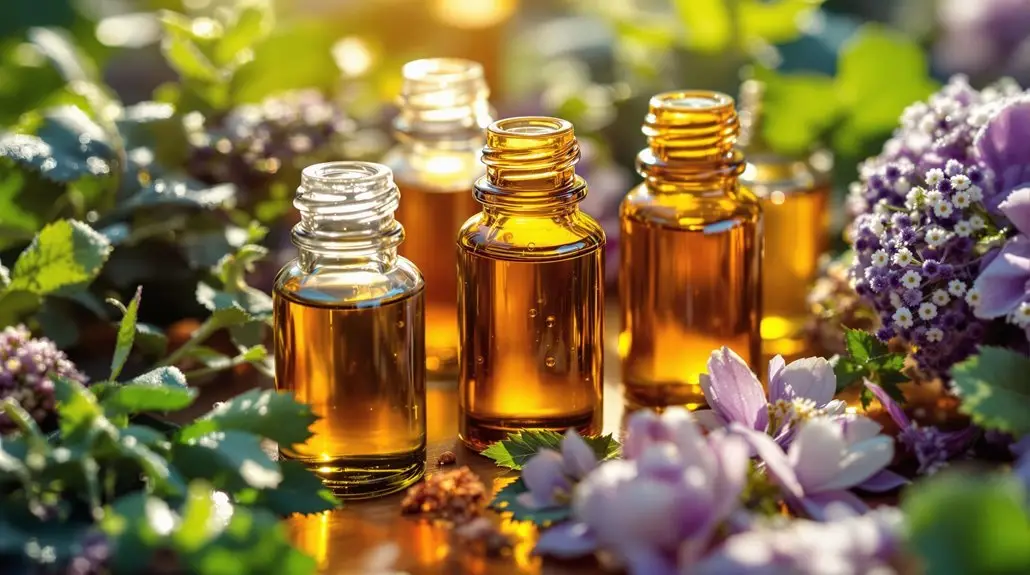
Essential oils are fascinating extracts that capture the essence of plants, showcasing their aromatic and therapeutic properties. You may not realize it, but these organic, volatile liquids are secreted by various plant parts, including seeds, leaves, fruits, flowers, resins, and woods. Each essential oil carries the unique scent and flavor of its source plant, and their concentrated nature makes them more potent than the botanicals themselves.
The magic lies in their complex composition, which includes a variety of constituents like monoterpenes, sesquiterpenes, and esters. The specific ratio of these components gives each oil its distinct wellness-enhancing qualities. To obtain these remarkable oils, methods such as steam distillation, cold pressing, and solvent extraction are employed. For instance, steam distillation heats plant materials over water, capturing the volatile compounds. Alternative methods are increasingly being explored for their efficacy in pest management.
Essential oils serve a multitude of purposes. You might use them in aromatherapy to promote relaxation or apply them topically to address skin concerns. They’re often added to diffusers, enhancing your environment and mood. With their ability to support health and well-being, essential oils have woven their way into various aspects of your everyday life, from skincare routines to natural remedies. Additionally, many essential oils exhibit anti-bacterial properties, making them valuable in promoting overall health.
However, it’s important to approach these oils with care. Their potency means that proper usage is vital for security. Choosing high-quality, pure oils makes a difference in ensuring you benefit from their therapeutic potential.
Effective Essential Oils for Pests
When it comes to pest control, your choice of essential oils can make a significant difference in keeping unwanted insects at bay.
If you’re dealing with troublesome mosquitoes, consider using citronella, which offers protection for up to five hours against various species. Lemon eucalyptus is another powerful option, boasting 95% effectiveness for about three hours. For outdoor adventures, rosemary can be your trusty ally, as mosquitoes tend to avoid it.
Don’t forget about peppermint oil! It’s not just for revitalizing your breath; it effectively repels mosquitoes, ticks, spiders, and flies. If you prefer a more fragrant approach, lemongrass is often combined with other oils for added mosquito protection. Rosemary is also effective against mosquitoes and enhances energy and mental alertness.
For ticks and fleas, thyme is a strong contender, known for its ability to repel ticks and chiggers while offering antimicrobial benefits. Lavender‘s soothing scent also acts against fleas, flies, and ticks, making it perfect for households.
You might also try rose geranium or cedarwood, both effective against ticks and fleas.
When tackling general household pests, peppermint shines again, deterring ants, roaches, and spiders. Sage and eucalyptus can add extra protection against flies and other insects.
For a unique touch, consider using catnip, known to repel mosquitoes, though it’s less common.
Mechanisms of Insect Control
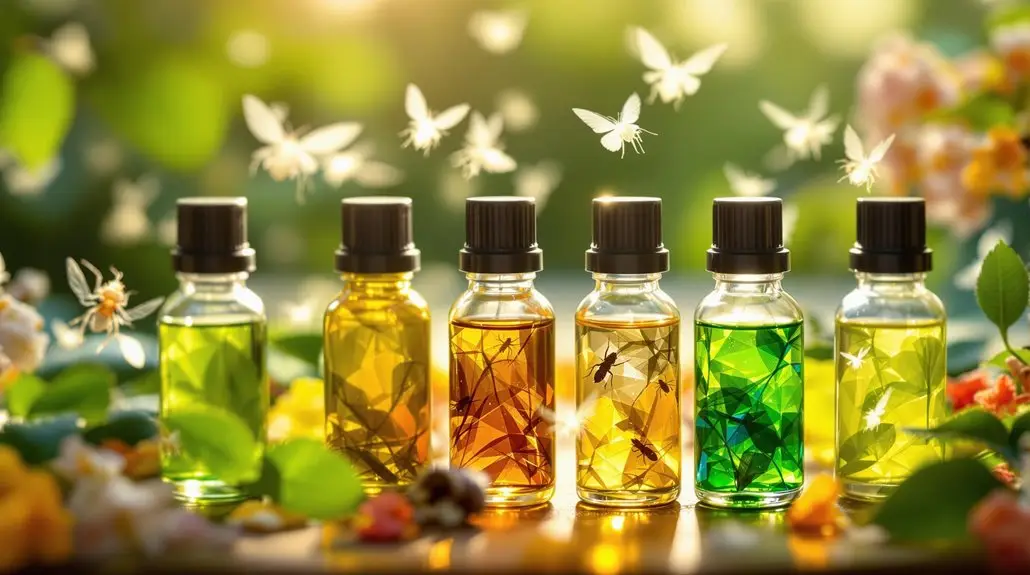
When you explore how essential oils control insects, you’ll notice their interaction with octopamine receptors plays a key role. These oils not only disrupt feeding behavior but also exhibit systemic toxicity effects, making them effective against various pests. Understanding these mechanisms can help you utilize essential oils more effectively in pest management strategies. Additionally, research shows that essential oils can have insecticidal activity against a wide range of pests due to their natural composition. Furthermore, utilizing organic pest control methods aligns with the principles of sustainability and environmental friendliness.
Octopamine Receptor Interaction
Octopamine receptors play an essential role in the behavior and physiology of insects, making them prime targets for pest control strategies. These receptors, including OctαR and OctβR, are critical for various insect activities, from locomotion to reproductive processes.
When octopamine binds to these receptors, it triggers a cell signaling cascade that can boost energy levels and affect behaviors important for survival. For instance, OctβR activation increases cellular cAMP, which is fundamental for energy-demanding actions like flying or jumping. Furthermore, understanding the role of rodents in pest ecosystems can enhance these targeted strategies.
The interaction between octopamine and its receptors is so specific that different receptor subtypes can exhibit varying sensitivities to octopamine. This specificity opens up exciting possibilities for developing targeted insecticides. Notably, the effectiveness of compounds like amitraz against Varroa populations highlights the potential for targeted pest management strategies.
Compounds like amitraz, which target Octβ2R, can disrupt normal insect behaviors and lead to mortality in pests while being less hazardous for beneficial insects like honeybees.
By understanding these interactions, you can appreciate how harnessing botanical essential oils that affect octopamine receptors could lead to innovative and sustainable pest control solutions that align with your commitment to environmental stewardship.
Together, we can explore a future where nature-friendly methods replace conventional insecticides.
Antifeedant Properties
Harnessing the power of essential oils can effectively create antifeedant effects, discouraging insects from munching on treated plants. By applying oils like peppermint and lavender, you can release strong scents that repel pests, making your garden less appealing to unwanted guests.
This approach is particularly effective against common nuisances like aphids, thrips, and whiteflies, which can wreak havoc on your plants. In addition, essential oils can interfere with insect biological systems, promoting repulsion and further enhancing pest control. Utilizing a holistic approach ensures minimal use of harmful chemicals while encouraging pest management.
When you treat your plants with these essential oils, you’re not just beautifying your garden; you’re also altering the feeding behavior of insects. The presence of these aromatic compounds can greatly reduce the damage they inflict.
Imagine stepping into your garden, knowing that the natural fragrances you’ve chosen are working to keep pests at bay.
You’ll find that utilizing these oils fosters a sense of community among fellow gardeners who share the same eco-friendly values. Together, you can embrace a sustainable approach to pest control that not only protects your plants but also promotes a healthier environment.
Systemic Toxicity Effects
Beyond antifeedant properties, botanical essential oils also exert systemic toxicity effects that effectively control insect populations. You’ll find that essential oils can be absorbed, ingested, or inhaled by insects, leading to significant mortality rates. For instance, eugenol from cloves shows high toxicity against pests like *R. ferrugineus*, with studies demonstrating an LC50 of 20.05 µL/L for α-pinene, another potent essential oil component.
Moreover, these oils can penetrate the insect cuticle, leading to contact toxicity, particularly effective against soft-bodied insects like aphids and thrips. Eugenol again shines here, causing substantial mortality among curculionids.
The neurotoxic effects of essential oils are equally impressive; they target the octopamine receptor system unique to insects, disrupting crucial signal pathways and ensuring a broad-spectrum impact. This action not only incapacitates pests but also helps prevent the insect resistance often seen with synthetic pesticides.
As you explore these options, you’ll appreciate that essential oils are biodegradable, secure for humans, and non-target organisms, making them a responsible choice for pest management.
Embracing these natural methods fosters a healthier environment for all.
Environmental Safety of Oils
The environmental security of botanical essential oils is an important consideration for anyone looking to implement them in pest control. You’ll be glad to know that these oils are non-toxic to mammals and humans. They target insect nerve receptor systems without affecting ours, making them secure for use around people. Compounds like rosemary oil and peppermint oil are recognized as secure by the FDA, meaning you can use them with confidence. Furthermore, many pest control companies, including NaturePest, utilize eco-friendly solutions that align with the use of essential oils in their treatments.
Another significant benefit is their biodegradability. Being natural and renewable, essential oils break down quickly, minimizing long-term environmental impact. Unlike synthetic pesticides, they won’t leave harmful residues or create toxic effects. You can apply these oils without worrying about re-entry intervals or waiting periods, allowing for immediate use in your gardens or homes.
While essential oils are generally secure for beneficial organisms like bees and butterflies, caution is necessary. Direct contact can harm soft-bodied beneficials, so timing your applications is vital. Some oils might affect aquatic life, so always consider where you’re spraying. Additionally, studies have shown that essential oils exhibit insecticidal actions, confirming their potential effectiveness against pest populations.
Regulatory compliance adds another layer of security. Essential oils meet the criteria set by the U.S. EPA, ensuring they’re effective and secure for agricultural use. Products like Ecotrol Plus, which contain these oils, are USDA approved and exempt from pre- or postharvest intervals.
In essence, using botanical essential oils for pest control provides a secure, effective, and environmentally friendly option that aligns with your commitment to sustainability.
Historical Uses of Essential Oils
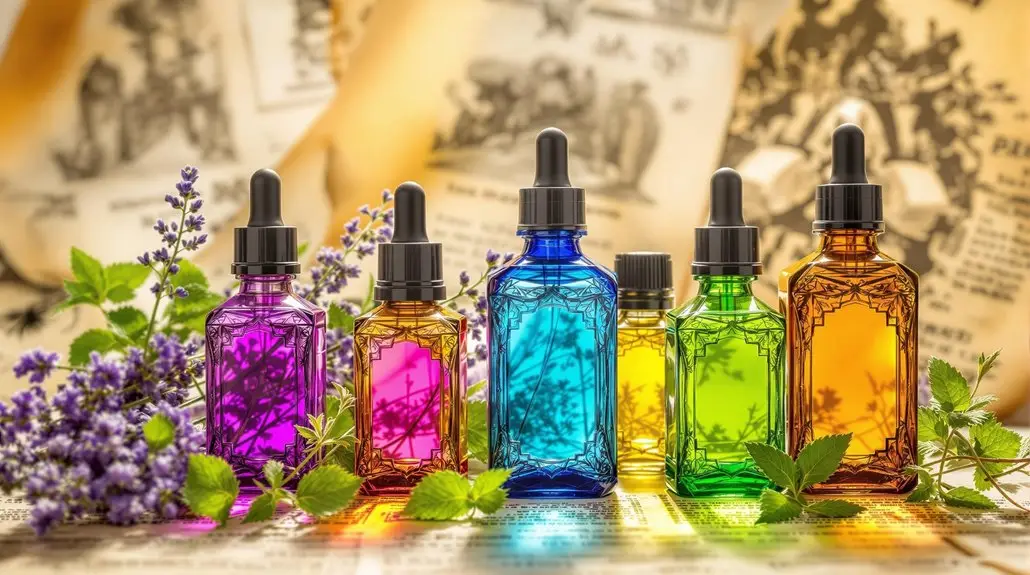
Throughout history, folks have turned to essential oils for various purposes, including pest control. Ancient cultures incorporated these oils into their daily lives, utilizing them in rituals, health practices, and even to keep insects at bay. Understanding these historical uses can shed light on how we might effectively apply essential oils today. In fact, the Egyptians utilized essential oils around 4500 BC for beauty and medicinal purposes, showcasing their versatility and significance in ancient life.
Ancient Pest Control Methods
From ancient China to the Roman Empire, civilizations have turned to essential oils as a natural solution for pest control. By 1,200 B.C., Chinese farmers were already harnessing these potent plant extracts to protect their stored food from pests. They often combined essential oils with wood ash and chalk to enhance their effectiveness. This method reflects the early use of biological pest management techniques that have been foundational in agriculture.
The Romans took a different approach, using controlled burns to manage locust populations, while by 450 B.C., mosquito nets became a common sight to ward off troublesome insects.
You might be surprised to learn which essential oils were favored. Peppermint, spearmint, and pennyroyal oils targeted ants and caterpillars, while cedarwood and orange oils kept aphids and moths at bay. Garlic and citronella oils helped combat beetles and flies, and lavender was used to fend off fleas and ticks.
Farmers didn’t just dabble in oils; they applied them in their gardens, mixing 6-8 drops per gallon in watering cans or spraying them directly on plants.
While not every method proved effective, these ancient practices laid the groundwork for our modern understanding of pest management, showing us the enduring power of nature’s solutions.
Cultural Practices and Traditions
Essential oils have woven themselves into the fabric of cultural practices and traditions for centuries, serving as natural insect repellents in households and gardens alike. You might be surprised to learn how versatile these oils have been throughout history.
For instance, oils like cedar, cinnamon, and citronella were incorporated into daily life, from fragrances to cleaning products, thanks to their insecticidal properties. Specific oils target specific pests, making them an invaluable resource in pest control.
In your own garden, consider the strong scents of peppermint and lavender, which not only smell delightful but also deter troublesome insects. Lavender oil, in particular, has long been celebrated for its multipurpose benefits, including repelling garden pests.
If you’re keen on DIY solutions, you can create homemade insect repellent sprays by diluting essential oils in vodka or witch hazel.
As you explore these traditions, remember that essential oils aren’t just a nod to the past; they’re dependable and effective today.
With many of these oils approved for food use and recognized for their safety, you can confidently embrace their benefits in your home and garden, fostering a sense of connection to those who came before you.
Essential Oils Through History
The rich history of essential oils spans thousands of years, revealing their profound impact on various cultures. From ancient civilizations to modern society, these aromatic extracts have been revered for their therapeutic properties and uses. You might find it fascinating that essential oils were utilized as far back as 4,000 years ago by the Egyptians for disinfection and embalming. Cleopatra herself indulged in them for beauty treatments!
Here’s a quick look at how essential oils evolved through time:
| Era | Key Developments |
|---|---|
| Ancient Civilizations | Used in Egypt, China, and India for health and beauty. |
| Middle Ages | Monks preserved knowledge; distillation advanced by Arabic alchemists. |
| Renaissance | European doctors studied and popularized essential oils. |
| Modern Era | Scientific recognition and commercial use expanded dramatically. |
Essential Oils in Agriculture
Incorporating botanical essential oils into agricultural practices offers a sustainable approach to pest management. You’ll find that these natural and biodegradable solutions not only protect your crops but also contribute to a healthier environment.
With low toxicity for mammals, essential oils guarantee security for non-target organisms and humans, making them a wise choice for conscientious growers like you.
These oils have proven effective against a wide range of pests threatening crops such as lettuce, coffee, and maize. Active components like carvacrol, linalool, and eugenol target the unique octopamine receptor system in insects, disrupting their neurotransmitter signals without harming you or your animals.
You can easily utilize essential oils through fumigation, ingestion, or contact methods, providing flexibility in your pest control strategies.
Practical applications make these oils even more appealing. Mixing essential oils with water and soap creates effective pest control sprays that cling to plant leaves, optimizing their impact.
Many essential oils, including rosemary and peppermint, are USDA approved and secure for use in food products, allowing you to harvest on the same day you spray.
Integrated Pest Management Strategies
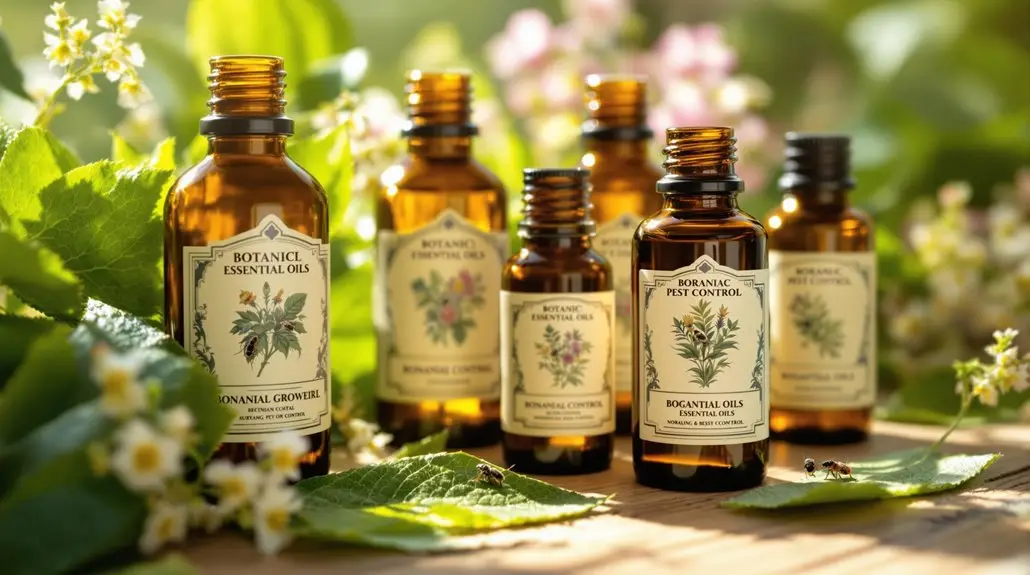
Botanical essential oils play a significant role in Integrated Pest Management (IPM) strategies, which focus on a thorough approach to pest control. By diversifying your pest management tactics, you can reduce reliance on synthetic pesticides and embrace natural alternatives like essential oils. This not only protects the environment but also minimizes risks associated with mammalian toxicity.
When you adopt IPM, you’re considering the economic aspects of pest control, seeking solutions that are both cost-effective and sustainable. Long-term sustainability is key; managing pest populations without causing resistance or ecological damage is crucial for future generations.
The multifaceted control approach of IPM combines physical, cultural, biological, and chemical controls, ensuring effective management of pests.
Integrating essential oils into your IPM strategy offers numerous benefits. Oils like cedarwood and peppermint repel insects, while clove and citrus provide contact and fumigant toxicity. Additionally, these oils can inhibit insect reproduction and feeding, helping to keep pest populations in check.
Since essential oils target the octopamine receptor found in insects, they’re harmless for humans and non-target organisms.
Formulation Techniques for Application
Formulating effective pest control solutions with essential oils requires careful consideration of several key techniques. By understanding these methods, you can create powerful formulations that align with your pest control goals while being mindful of the environment.
Here are four essential formulation techniques to keep in mind:
- Essential Oil Selection and Blending: Choose oils like cedarwood, peppermint, lavender, clove, and orange for their strong pest-repelling properties. Blending different oils can enhance effectiveness against various pests.
- Dilution and Mixing: Dilute essential oils with water to prevent plant damage and guarantee even coverage. Adding a small amount of soap helps the mixture cling to plant surfaces. Shake well before each use for uniform distribution.
- Stability and Shelf Life: Since essential oils are volatile, make your formulations fresh whenever possible. Store them in dark, cool places to prolong shelf life. Consider using emulsifiers to prevent separation.
- Security and Environmental Considerations: Essential oils are generally secure for humans and non-target organisms, but apply them carefully to avoid harming beneficial insects. Many essential oils are biodegradable, making them eco-friendly options.
Application Methods for Effectiveness
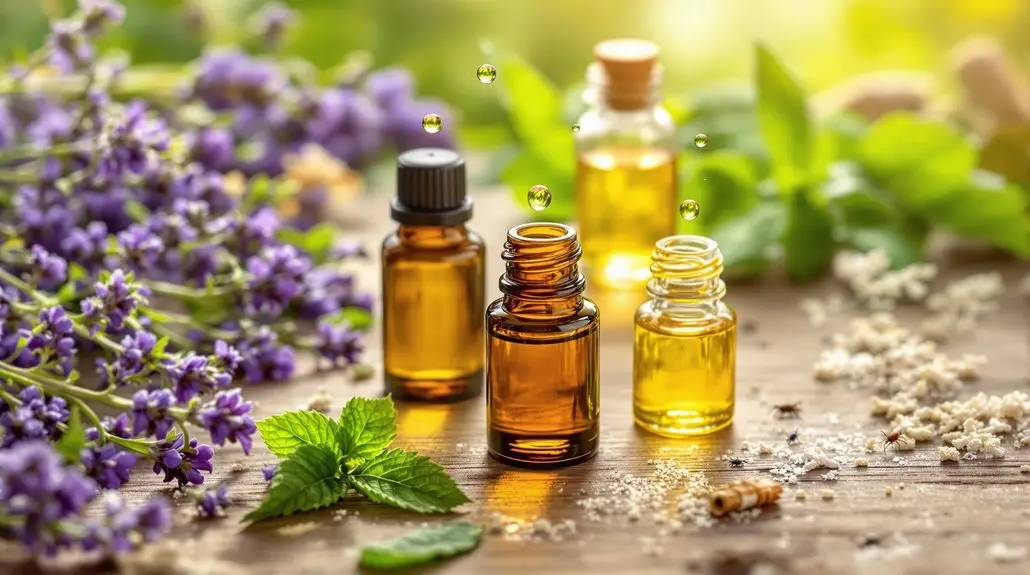
Effective application methods are key to maximizing the benefits of botanical essential oils for pest control. Start by strategically placing essential oils throughout your home. A few drops on cotton balls tucked into corners or diluted mixtures sprayed around doorways and windows can create an effective barrier against pests.
Don’t forget to use oils in linen cupboards to repel moths and leave lavender oil in a saucer to deter ants.
When it comes to devices, atomizers work wonders for dispersing oils like lavender and basil. You can also employ diffusers to create a pest-repelling atmosphere in your living spaces. Adding essential oils to your cleaning solutions enhances pest control while also making your home smell great.
For outdoor applications, consider combining essential oils with water and soap to create a garden pest spray. Apply this mixture liberally, especially after rain, and use oils like cedarwood or peppermint for their insecticidal properties.
Reapply regularly to maintain effectiveness, especially around outdoor furniture or during gatherings on the patio.
If you’re targeting specific pests, like mosquitoes or rodents, you can use oils like basil and peppermint for their repellent qualities. Remember to dilute your oils and verify they’re secure around kids and pets.
With these methods, you’re not just keeping pests at bay; you’re creating a welcoming environment for everyone in your space. Your home can be both cozy and pest-free!
Benefits for Non-Target Organisms
Using botanical essential oils for pest control not only benefits your home but also supports environmental health and protection for non-target organisms.
By choosing these eco-friendly alternatives, you’re actively protecting the delicate balance of your local ecosystem. Here are four key benefits you can embrace:
- Environmental Security: Essential oils are biodegradable and won’t linger in the environment like synthetic pesticides, minimizing long-term ecological impact.
- Protection for Mammals and Humans: These oils target insect-specific nerve receptors, ensuring they won’t affect you or your pets. Many are even FDA-approved for food safety!
- Protection of Beneficial Insects: You can minimize harm to essential pollinators like bees and butterflies by timing your applications and avoiding direct contact.
- Regulatory Compliance: Essential oils meet U.S. EPA and USDA standards, ensuring their secure use in both agricultural and household settings.
Case Studies in Pest Control
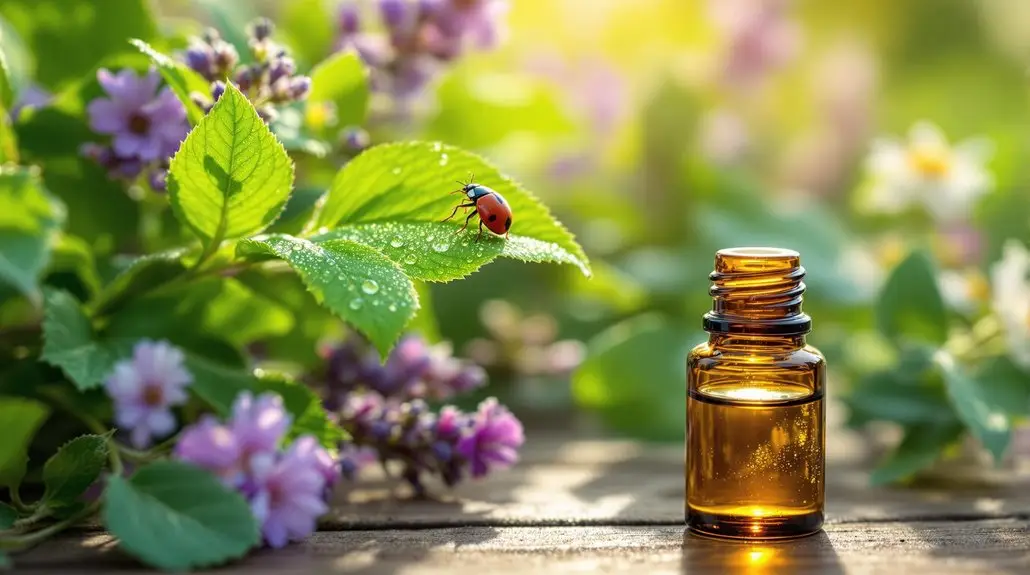
Exploring case studies in pest control reveals the significant impact botanical essential oils can have on various insect pests. For instance, in tackling stored product pests like the granary weevil (*Sitophilus granarius*), essential oils from *Allium sativum* and *Eucalyptus dives* show impressive toxicity.
You’ll find that *Satureja hortensis* essential oil provides high fumigation toxicity, while eugenol from cloves and nutmeg effectively combats these pests with an LC50 of just 2.765 µL/mL.
When it comes to agricultural pests, eugenol is particularly effective against various members of the Curculionidae family. It’s been reported that cinnamon oil achieves a lethal concentration of 0.69 µL/cm² against *Sitophilus zeamais*.
Essential oils from *C. lusitanica* also demonstrate contact toxicity, resulting in a 59.2% mortality rate.
In urban settings, controlling ants can be just as effective. Mint oil yields a remarkable 49–100% repellency against *Solenopsis invicta*.
You might also discover that the essential oil from *Cupressus nootkatensis* exhibits both contact and fumigant toxicity against invasive ant species.
Lastly, when repelling mosquitoes, oils from *Juniperus communis* and *Ocimum basilicum* prove to be powerful allies.
All these case studies highlight the practicality and effectiveness of botanical essential oils in pest management, creating a more sustainable environment for all of us.
Future of Essential Oils in Pest Management
The future of essential oils in pest management looks promising as their natural properties align perfectly with the growing demand for sustainable agricultural practices.
As you consider embracing these eco-friendly solutions, here are some key benefits that stand out:
- Biodegradable and Secure: Essential oils break down naturally, leaving no toxic residues, making them secure for you and the environment.
- Efficacy Against Pests: They can effectively combat a variety of pests like mosquitoes, ticks, and ants, offering a versatile solution for your pest management needs.
- Reduced Resistance Development: Unlike synthetic pesticides, essential oils don’t contribute to the development of resistance in pests, ensuring their long-term effectiveness.
- Integrated Pest Management (IPM): By integrating essential oils into existing pest management strategies, you can enhance both sustainability and effectiveness.
While essential oils present exciting opportunities, challenges remain, such as their volatility and the need for careful application to avoid phytotoxicity.
However, ongoing research aims to improve the stability and reliability of these oils, paving the way for more effective formulations.
As you explore sustainable practices, the integration of essential oils into your pest management toolkit can offer a natural, effective, and environmentally friendly approach.
Together, we can cultivate a healthier ecosystem while enjoying the benefits of nature’s pest control solutions.
Frequently Asked Questions
Can Essential Oils Be Used Indoors for Pest Control?
Yes, you can definitely use essential oils indoors for pest control! Oils like peppermint, citronella, lavender, and tea tree oil are effective at repelling common pests.
You can spray them at entry points or use sachets in closets and kitchens. Mixing these oils with a carrier or alcohol enhances their effectiveness.
Plus, they add a pleasant aroma to your space while keeping unwanted insects at bay. It’s a natural, inviting solution for your home!
How Long Do the Effects of Essential Oils Last on Plants?
Using essential oils on plants is like wrapping them in a fragrant shield.
However, their effects don’t last forever. Because essential oils are volatile, they can degrade quickly due to moisture, light, and air.
To keep their potency, you’ll need to apply them regularly, especially after rain.
Think of frequent applications as giving your plants a revitalizing boost, ensuring they stay protected against pests while you nurture your green space.
Are There Any Known Side Effects of Using Essential Oils?
Yes, there can be side effects when using essential oils. You might experience skin irritation or allergic reactions if you apply them directly.
Also, some oils can be toxic to pets, so it’s wise to check labels and consult your vet.
When using oils in aromatherapy, guarantee proper ventilation to avoid headaches or nausea.
Always do a patch test first to see how your skin reacts. Your protection and comfort should always come first!
Can Essential Oils Harm Beneficial Insects Like Bees and Butterflies?
Yes, essential oils can harm beneficial insects like bees and butterflies if not used carefully.
You should apply them during times when these insects are less active, like early mornings or late evenings.
It’s vital to dilute the oils properly and guarantee they’re fully dried before beneficials come into contact with treated plants.
Always remember to follow application guidelines to protect our valuable pollinators while managing pests effectively.
How Should Essential Oils Be Stored for Maximum Effectiveness?
To store essential oils for maximum effectiveness, keep them in a cool, dry place away from direct sunlight.
Use dark glass bottles that are airtight to prevent oxidation. It’s best to use smaller bottles to limit air exposure when you open them.
Regularly check for any changes in color or odor, and remember to label your containers with contents and storage dates.
These simple steps will help maintain their potency and guarantee you get the best results.
Embrace Nature’s Remedy: Safer Pest Control with Botanical Essential Oils
In a world where synthetic pesticides reign supreme, it’s ironic that nature’s own concoctions—botanical essential oils—hold the key to more secure pest control. Imagine a garden where fragrant oils dance in the air, effortlessly repelling unwanted guests while nurturing beneficial allies. As we embrace these aromatic solutions, we not only protect our crops but also respect the delicate balance of our ecosystem.
At NaturePest Holistic Pest Control, we believe it’s time to let nature’s perfume lead the way in pest management. Join us in discovering the power of botanical essential oils and experience a simpler, more effective approach to pest control that is safe for your family and the environment. Together, we can create thriving gardens that celebrate nature’s harmony. Contact NaturePest today and take the first step towards a healthier, pest-free future!

